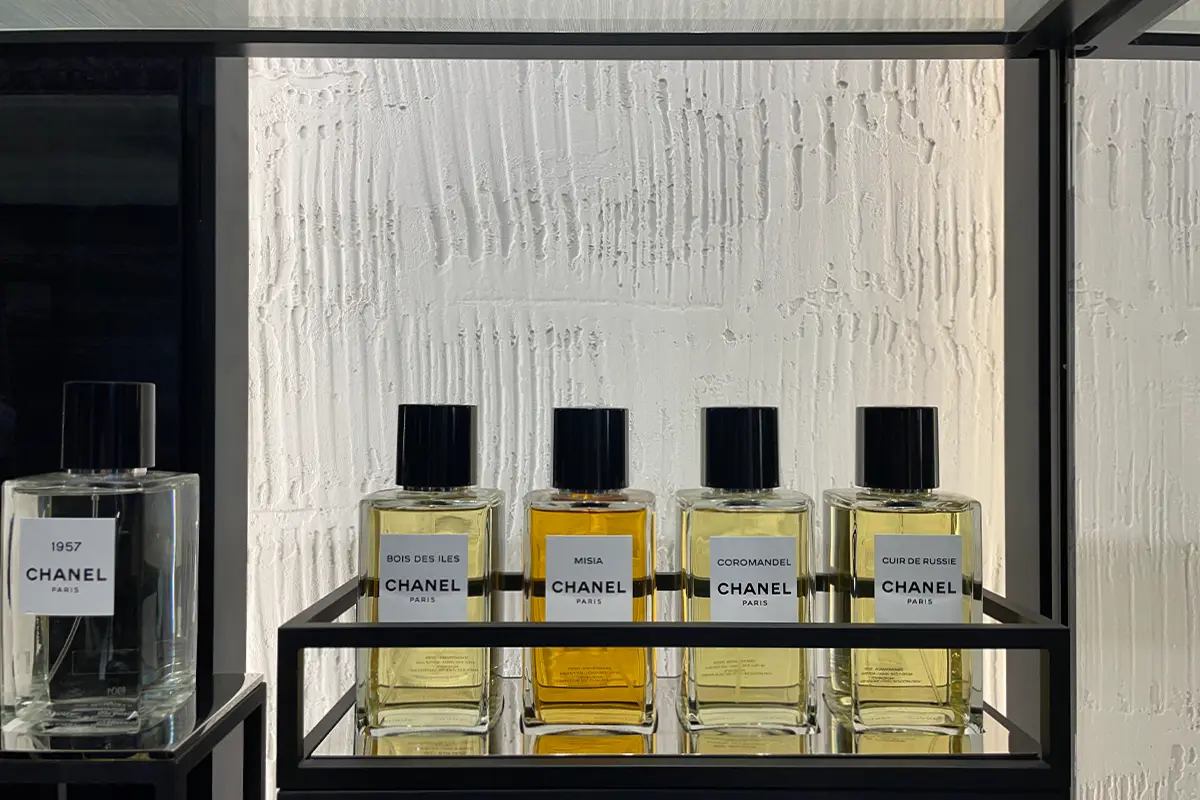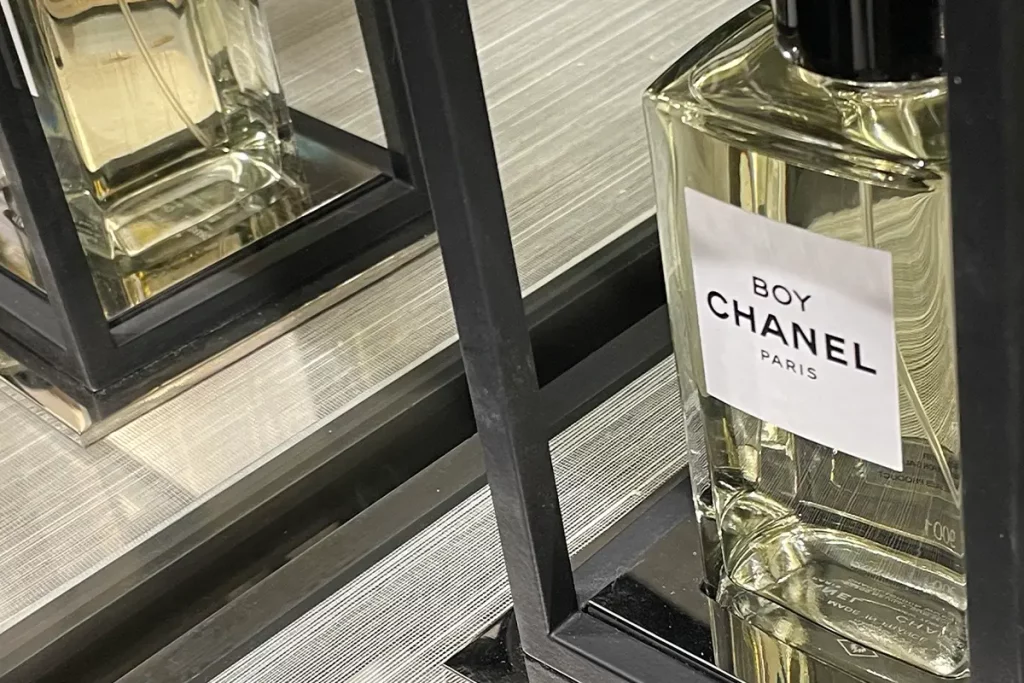Henri Robert, Jacques Polge, and Olivier Polge, inherited Beaux’s duty to maintain N°5’s production, preserving raw materials while reinventing it. In 2007, Chanel Les Exclusifs was born.
From Chanel N°5 to Les Exclusifs de Chanel – the evolution of the Maison in the realm of perfumery starting from raw materials
Mademoiselle Chanel was the first fashion designer to create perfumes under her name. Her idea was to liberate femininity from traditional floral scents. To depart from the single floral essences of the 1920s, she worked with artisan Ernest Beaux on her initial fragrances. Beaux’s perfume in 1921, rich in Grasse flowers, set the standard for Chanel N°5 and changed the world of perfumes.
Successive perfumers, Henri Robert, Jacques Polge, and Olivier Polge, inherited Beaux’s duty to preserve Chanel N°5 and its raw materials. From 1978 to 2013, Jacques Polge’s role was to create new fragrances while maintaining the legacies of Ernest Beaux and Henri Robert. Nowadays, Chanel N°5 boasts five different interpretations, from Eau de Toilette, Eau de Parfum to l’Eau, including the original Perfume.
Mademoiselle Chanel and Ernst Beaux kept matching perfumes with new garments. As a result, N°22, Bois des Îles, Cuir de Russie, and Gardénia came to life. Those perfumes are now part of the Les Exclusifs collection.
Heritage, innovation, and craftsmanship form the foundation for Les Exclusifs de Chanel perfume collection
It is in 2007 that Chanel established Les Exclusifs de Chanel, a collection paying homage to its perfumes and creator. These fragrances celebrate Chanel’s heritage and iconic elements, each representing a chapter in Chanel’s story. They act as guiding principles and thematic threads, shaping the character of each scent. Conceptual pillars such as heritage, innovation, and craftsmanship form the foundation for the Les Exclusifs de Chanel collection.
The collection features four historical fragrances created in the 1920s by Ernest Beaux for Coco Chanel: N°22, Gardenia, Bois de Iles, Cuir de Russie; ten fragrances created by Jacques Polge: Eau de Cologne, 31 Rue Cambon, Coromandel, La Pausa, Bel Respiro, N°18, Sycomore, Beige, Jersey, 1932; four fragrances created by Olivier Polge: Misia, Boy, 1957, Le Lion.
Inspired by Chanel’s geography – numbers, locations, and houses that became symbols – these fragrances trace the line of Coco’s life.
In 1921, the launch of Chanel N°5 disrupted the conventional norms and principles within the perfume industry
A series of fragrances in the collection, including N°22, Cuir de Russie, Gardénia and Bois des Îles, draw inspiration from the heritage fragrances crafted by Ernest Beaux. His union with Mademoiselle Chanel in 1920 marked the convergence of two non-conformist spirits.
In 1921, the launch of N°5 disrupted the conventional norms and principles within the perfume industry. A year later, N°22 was introduced, bearing the number of its creation date. Comprising aldehydes, iris, ylang-ylang, rose, jasmine, incense, and vetiver, N°22 stands as a variation of N°5.
Coco Chanel held an admiration for white flowers, particularly the scentless camellia, which became her and the house’s emblem. Despite the flower’s lack of natural fragrance, Ernest Beaux and Coco Chanel harnessed synthetic chemistry in 1925, to create an olfactory representation of the gardenia.
31 Rue Cambon, Coromandel, Bel Respiro and La Pausa captured moments from the life of Mademoiselle Chanel
Coromandel is a homage to Chanel’s love for Chinese lacquered coromandel screens. Mademoiselle Chanel’s discovery of her first coromandel at the age of twenty intrigued her. These screens not only gave the Rue Cambon an air of encampment but also provided Chanel with a sense of protection.
Inspired by Chanel’s Paris Atelier, the fragrance at 31 Rue Cambon opens with a blend of bergamot, aldehyde, and pepper, followed by iris and ylang-ylang, with rose and jasmine, all anchored by amber and patchouli.
Moving to Bel Respiro, the villa that Mademoiselle Chanel acquired in 1920 in Garches served as a meeting point for Parisians at the time, with its beige rendering and black shutters. Jacques Polge crafted a fragrance able to captures refinement of that ideal spring, with notes of cut grass, daffodils, and aromas of garrigue, thyme, rosemary, and basil from a vegetable garden.
La Pausa was Mademoiselle Chanel’s vacation home built on land purchased in 1928 above Roquebrune Cap Martin, in Southern France, featuring colonnades and green shutters. The fragrance embodies notes of pink berries and the woody scent of vetiver.
Searching for mixing feminine and androgynous fragrances: Chanel’s N°18, Jersey, and Sycomore
N°18 and Jersey redefine floral compositions with a modern expression. The blend of Musk mallow essence, pear, and subtle florals, on a woody iris base, exemplifies this departure. N°18 is, on the other side, the collection’s most androgynous release.
In the quest to redefine femininity, Jacques Polge draws inspiration from Coco Chanel’s reinterpretation of masculine styles, as seen in Jersey. This fragrance feature lavender, vanilla, and white musk. A nod to Coco’s vision, the 1930 creation, Sycomore, envisions a woody scent. Housed in a light wood case, the fragrance reflects the essence of a dry, robust trunk, serving as a metaphor for Coco Chanel’s tenacity, with a subtle spicy undertone.
Chanel beauty: the evolving journey of Chanel’s Les Exclusifs collection
Under the guidance of both Jacques Polge and his successor, Olivier Polge, the collection has expanded over the years. New fragrances like Misia, Boy, and 1957 exemplify the brand’s ability to evolve while preserving the essence of Chanel. In 2015, Olivier Polge, the new perfumer for Chanel, introduced his inaugural fragrance for this collection, Misia Sert. «My inspiration for this perfume wasn’t so much Misia as a person, but the turning point she represented in Gabrielle Chanel’s life». Misia Sert was an acclaimed pianist and Coco’s friend and muse. Following Misia, came the fragrances Boy, 1957, and today, Le Lion.
Symbolizing strength and power, the lion is a recurring motif in the Les Exclusifs collection, holding meaning in Coco Chanel’s life. Le Lion represents Chanel’s venture into the amber oriental category.
Craftsmanship with Les Exclusifs de Chanel: the Discovery Set
The Les Exclusifs de Chanel collection itself signifies exclusivity, with selected materials and a limited distribution. The fragrances are presented in monolithic 200ml glass vessels with weighty black gloss magnetic CC-embossed caps.
A set case with miniature exclusive and limited-edition of Les Exclusifs de Chanel fragrances is also available. Crafted as a gift, the discovery set allows for the exploration of the eighteen compositions in the collection, along with Huile Douce.
Les Exclusifs de Chanel
Les Exclusifs de Chanel collection aims at capturing the essence of Coco Chanel’s life elements associated with the Chanel brand, through perfumery. The collection features four historical fragrances created in the 1920s by Ernest Beaux, ten fragrances by Jacques Polge, and four by Olivier Polge.




















